
Extraordinary Artifacts
More than 20 of them have turned up across the American West,
including one unearthed in a Colorado backyard in 2008. They
have been found by construction crews, artifact collectors,
and in one case by a man hand-digging an irrigation canal.
They are the Clovis caches, groupings of exquisitely carved
spear points and other flaked stone artifacts crafted
thousands of years ago. Were they stored for a planned
retrieval that never came? Were they ritual objects used in
sacred ceremonies or as grave goods? Did the ancients use them
for all three purposes? No one knows. But that only adds to
their fascination for us today. Here, savor the skill and
workmanship, the artistry and mystery, of 10 artifacts from
perhaps the most spectacular of these early American
collections, the Fenn Cache.—Peter Tyson
Note on the photographs
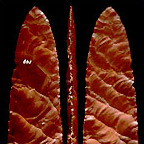

|
|
Artifact #149
The showpiece of the Fenn Cache, this is one of the
finest Clovis points ever found. The Clovis were a
prehistoric people who flourished in North America at
the end of the Ice Age, hunting mammoths and other big
game with spear points not unlike this one. To make the
point, Clovis knappers used a billet, a hammer of ivory
or antler, to flake off pieces of the point through a
process known as brittle fracture. This point, crafted
from red jasper, reveals an unusual flaking style: Its
maker struck the point diagonally rather than from side
to side, as was the norm.
|
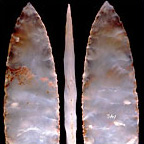

|
|
Artifact #142
Fashioned from Utah agate, this is a classic Clovis
point in size, flaking, and proportions. It is in such
perfect condition that experts suspect it may never have
been used, bolstering the hypothesis that such caches
may have served a ritual purpose. Like all but one of
the Fenn artifacts, this point bears a residue of red
ocher, an iron-rich pigment that Stone Age cultures
often used in ceremonies.
|
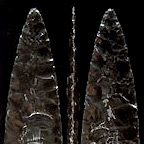

|
|
Artifact #107
The scratches visible on the flaked base, or flute, of
this obsidian point revealed a residue of fossil pine
pitch. Experts believe the first step the Clovis took in
attaching their points to spears or knife handles was to
smear tree resin on each point's flute to serve as a
kind of glue. They then wedged the sticky end of the
point into a groove carved into the business end of the
weapon's wooden or bone shaft and bound the two together
with sinew.
|
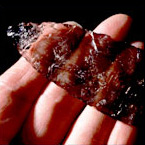

|
|
Artifact #154
Made of smoky quartz crystal, this point is transparent.
Its shape suggests to experts that it may have once been
part of a larger point. While the stone used in many
points can be traced to a particular rock formation or
region, the original home of this stone is unknown.
|


|
|
Artifact #151
No one knows what this crescent-shaped tool was used
for, though it has turned up in association with Clovis
points elsewhere. While the tool's middle edges are dull
from grinding, its ends remain sharp. It is made of
chert from the Green River Formation of southwestern
Wyoming and contiguous parts of Utah and Colorado. This
is not far from where the cache is believed to have been
found, the three corners area where Utah, Wyoming, and
Idaho come together.
|


|
|
Artifact #152
Also of Green River Formation chert, this artifact is
similar to other Clovis blades. Flaked from a stone core
carried as source material, blades were fashioned into
knives, scrapers, and other tools. The edges of this
blade are dull, possibly as a result of use. Although
the cache's discoverer died before sharing details of
his discovery, he is thought to have found it around
1902 in a rockshelter or at the base of a cliff. Another
story says he unearthed it during plowing, though none
of the artifacts shows evidence of plow damage.
|
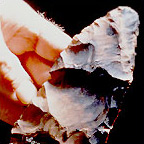

|
|
Artifact #116
This chert point shows superior control of "overshot
flaking." In this process, Clovis knappers struck across
the point in such a way as to remove a flake that
included a portion of the opposite face. They used
overshot flaking to quickly thin a point, but they had
to be careful—an improper strike could result in
taking too large a chunk off the edge. This point is not
fluted and may not be finished.
|


|
|
Artifact #104
This specimen shows worn ridges on its flake scars,
which may suggest that it rubbed repeatedly against
other artifacts it was packed with during transport,
possibly in a bag. With a variety of quality rock and
mineral types represented in the cache—this point
is made of obsidian—it is clear that its owner
either traveled far to procure specific types of stone
or traded with others who did. In either case, the stone
in the Fenn and other caches was hand-carried great
distances.
|


|
|
Artifact #111
This Clovis biface—or two-faced point with a
continuous edge—is made of Green River Formation
chert. Though precisely when the Fenn artifacts were
made is unknown, experts used a process known as
hydration analysis to get a rough idea of when two
obsidian points in the cache were created. When a newly
broken piece of obsidian is buried in soil it begins to
absorb water, forming a "hydration rind." Experts can
use the thickness of this rind to roughly determine age,
which in the case of the two obsidian points tested was
thousands of years old.
|
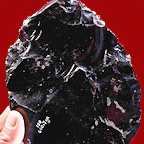

|
|
Artifact #100
At over eight inches long and nearly one and a half
pounds, this obsidian piece is the largest artifact in
the Fenn Cache. All told, the 56 artifacts in the cache
weigh about 18 pounds, a significant load for a hunter
likely also carrying food, tools, and other items. The
weight and quality of the artifacts, along with their
association with ocher, their pristine nature in many
cases, and the simple fact that they were found together
hint that this was a prized collection for one or more
of America's first inhabitants.
|
Note: The photographs, many of which show both faces and one
edge of each artifact, were taken by Peter Bostrom (Lithics
Casting Lab, Troy, Illinois), who used a 4x5 camera and
triple-exposed each image. To view his photos of all 56
artifacts in the collection, see
The Fenn Cache: Clovis Weapons and Tools, by George
Frison and Bruce Bradley (Santa Fe: One Horse Land & Cattle
Company, 1999). This feature originally appeared, with the
title "The Fenn Cache" and in slightly different form, on
NOVA's
America's Stone Age Explorers
website.
|

|











